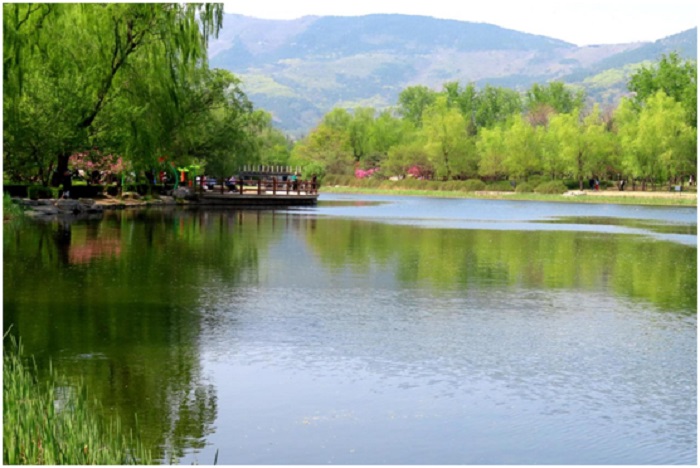



The newly inaugurated China National Botanical Garden in Beijing is bursting with vibrancy and vigor. The garden houses many important plant resources, including the seeds of sea coconut, which can weigh up to 25 kilograms; seeds of rattlesnake plantain that are as light as floating dust; as well as more than 200 Chinese and foreign varieties of peony.
National botanical garden serves as plant diversity conservation base in China. Acting by the principle of striking a balance between on-site and translocation conservation, China has started building a system of national botanical gardens in places like Beijing and Guangzhou, capital of south China’s Guangdong province, said Chinese President Xi Jinping at the Leaders’ Summit of the 15th Meeting of the Conference of the Parties to the Convention on Biological Diversity.
The newly inaugurated China National Botanical Garden, a vital component of the system of national botanical gardens, has been built on two sites and is the result of improvement in and integration of resources of the Institute of Botany under the Chinese Academy of Sciences (the southern site) and the Beijing Botanical Garden (the northern site).
With a projected size of nearly 600 hectares, the botanical garden will collect over 30,000 kinds of plants and house five million representative plant specimens from five continents, leading the country in scientific research and ex-situ conservation of plants.
The China National Botanical Garden will continue to complete projects including plant science research center, ex-situ conservation research center, germplasm resources preservation center, the second phase of a specimen room project, and greenhouses for plant specimens from five continents, and build 28 special parks with distinctive characteristics.
Rich collections of plant species are a highlight of national botanical gardens in China. There are two basic approaches to the conservation of plant resources: in-situ and ex-situ conservation. Unlike regular botanical gardens and parks, China’s national botanical gardens are set up mainly for scientific research and ex-situ conservation of plant resources.
Rich collections of plant species are the foundation of many endeavors, be it ex-situ conservation of plant resources, plant science research, science popularization or garden and horticulture display.
More than 15,000 species of plants are under ex-situ conservation in the China National Botanical Garden, among which nearly 1,000 are rare and endangered, including more than 300 species on the List of China’s State-Protected Key Wild Plants.
Since 2004, Beijing Botanical Garden has carried out survey on the resources of Cypripedium and research into the conservation and breeding of Cypripedium in Beijing, restoring the population of Cypripedium tibeticum King ex Rolfe, an endangered species.
The national botanical garden will continue making efforts to establish and improve a dynamic plant protection system that encompasses the whole plant life cycle in order to successfully safeguard threatened plant species, endemic species, and species of significant economic significance.
In addition to the integration of advantageous resources, the expansion of social service function is also a critical part in upgrading a botanical garden to a national botanical garden.
National botanical gardens in China not only carry out scientific research and ex-situ conservation of plant resources, but function as integrated facilities for science popularization, garden and horticulture display, and ecological leisure activities.
Visitors may get so much knowledge in the southern section of the China National Botanical Garden, which is home to magnolias, roses, crustaceous plants, and other plant groupings, that they feel as if they have opened a book on the history of plant evolution. The northern part of the national botanical garden has a science museum, which enables visitors to closely observe and learn knowledge about living plants, plant specimens, scientific botanical illustrations, etc.
While carrying out scientific research and ex-situ conservation of plant resources, China’s national botanical gardens also provide visitors with plant science education, technical training, and services related to health, tourism, and relaxation to help more people appreciate and enjoy the beauty of nature. These functions are the charms of the national botanical gardens.
China is among the countries with the richest biodiversity in the world. It is home to more than 37,000 species of known higher plants, which account for roughly 10 percent of the global total. Plant science research in China has enjoyed rapid development in recent years, yet the field still needs to improve weak links in certain aspects.
By selecting and building a number of national botanical gardens and achieving organic connection and mutual complementarity between these botanical gardens and China’s in-situ conservation system with national parks as the mainstay, the country will be able to realize full coverage of the conservation of plant diversity and the sustainable use of plants, and finally achieve the goal of putting more than 85 percent of its native wild plant species and all key protected plant types under ex-situ conservation.


The Humanitarian Service Diamond Awards has.
A Chinese Company, Inner Galaxy Steel.


The Programme Coordinator, Regulatory, Compliance and.


A Non-Governmental Organization (NGO), Committee for.
The Trustfund Pensions Limited has chided.


The House of Representatives Committee on.
The China General Chamber of Commerce.


Senator Chuka Utazi who represented Enugu.


An Abuja based Legal Practitioner, Ugochukwu.


The African business community in Yiwu,.
Leave a Comment